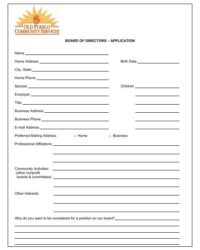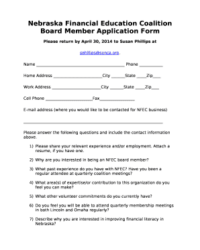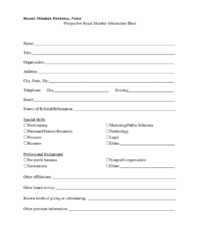Utilizing such a framework offers candidates a clear roadmap for highlighting relevant skills and accomplishments, increasing the likelihood of a compelling and persuasive application. It can also save applicants valuable time and effort by providing a pre-designed format, allowing them to focus on articulating their unique value proposition. Furthermore, standardized applications enhance transparency and fairness in the selection process.
This discussion will further explore key elements often included in these structured frameworks, providing practical guidance for both creating and utilizing them effectively. Topics covered will include crafting compelling narratives, showcasing relevant experience, and understanding the specific requirements of different organizations.
Key Components of a Board Application Framework
Effective applications for board positions require careful consideration of several key components. These components work together to present a comprehensive picture of a candidate’s suitability for the role.
1. Contact Information: Clear and accurate contact details are essential for efficient communication throughout the selection process. This section should include full name, address, phone number, and email address.
2. Letter of Introduction: A concise and compelling letter should introduce the candidate and highlight their key qualifications and motivations for joining the board. This is an opportunity to showcase alignment with the organization’s mission and values.
3. Professional Summary or Resume: A detailed overview of professional experience, skills, and accomplishments should be provided, emphasizing relevant expertise and leadership roles. This section demonstrates the candidate’s capacity to contribute meaningfully to board discussions and decisions.
4. Board Experience (if applicable): Prior board experience, including specific roles, responsibilities, and accomplishments, should be clearly outlined. This section demonstrates a candidate’s understanding of board governance principles and practices.
5. Skills and Qualifications: Candidates should articulate specific skills and qualifications that align with the board’s needs and strategic priorities. This might include financial acumen, strategic planning expertise, legal knowledge, or fundraising experience.
6. References: Providing a list of professional references allows the selection committee to gather further insights into a candidate’s character, capabilities, and experience. Contact information for each reference should be included.
7. Statement of Commitment: A clear articulation of the candidate’s commitment to the organization’s mission, vision, and values underscores their genuine interest and dedication. This section can also address the candidate’s understanding of the time commitment required for board service.
A well-crafted application demonstrates a candidate’s understanding of the board’s role and their potential contribution to its success. Providing comprehensive and relevant information in a clear and concise manner strengthens the application and facilitates the selection process.
How to Create a Board Position Application Template
Developing a standardized template for board position applications ensures consistency and efficiency in the candidate selection process. The following steps outline the creation of a comprehensive and effective template.
1: Define Required Information: Determine the essential information needed from applicants. This typically includes contact details, professional experience, qualifications, and board-specific skills.
2: Structure the Template: Organize the required information into distinct sections. Logical categories might include contact information, letter of introduction, professional summary, board experience, skills and qualifications, references, and statement of commitment.
3: Develop Clear Instructions: Provide concise and unambiguous instructions for each section. Guidance on formatting, content length, and required details ensures applicants provide consistent and comparable information.
4: Incorporate Relevant Questions: Include specific questions that elicit information directly relevant to the organization’s needs and the board’s strategic priorities. These questions should encourage candidates to articulate their unique value proposition.
5: Design for Accessibility: Ensure the template is accessible to all potential applicants. Consider providing the template in multiple formats (e.g., Word document, PDF) and adhering to accessibility guidelines for online forms.
6: Test and Refine: Before widespread use, pilot test the template with a small group of individuals. Gather feedback and refine the template based on user experience and identified areas for improvement.
7: Disseminate the Template: Make the template readily available to potential applicants through appropriate channels, such as the organization’s website or application portal.
A well-designed template simplifies the application process for candidates while providing selection committees with the information necessary to evaluate applicants effectively. Regular review and updates ensure the template remains relevant and aligned with evolving organizational needs.
Standardized frameworks for board position applications offer significant advantages to both organizations and candidates. These frameworks ensure a consistent and efficient evaluation process by providing a structured approach to presenting qualifications, experience, and motivations. Clear guidelines and targeted questions enable applicants to showcase their unique value proposition effectively. This streamlined approach promotes transparency and fairness throughout the selection process, ultimately contributing to the identification of highly qualified and committed individuals for board service.
Effective governance relies on the contributions of dedicated and skilled board members. Implementing structured application processes is a crucial step towards building high-performing boards equipped to navigate complex challenges and guide organizations towards a successful future. A commitment to robust recruitment practices strengthens organizational leadership and fosters a culture of good governance.


